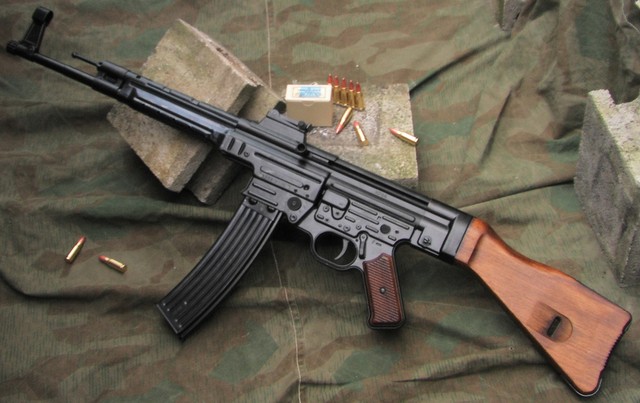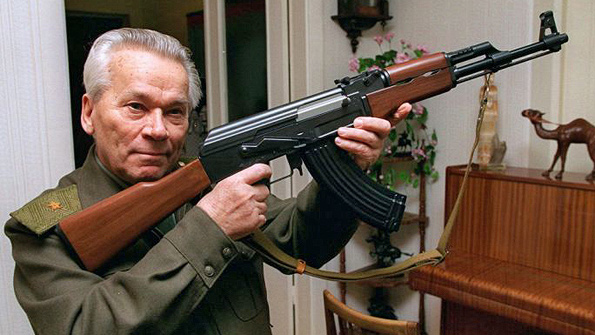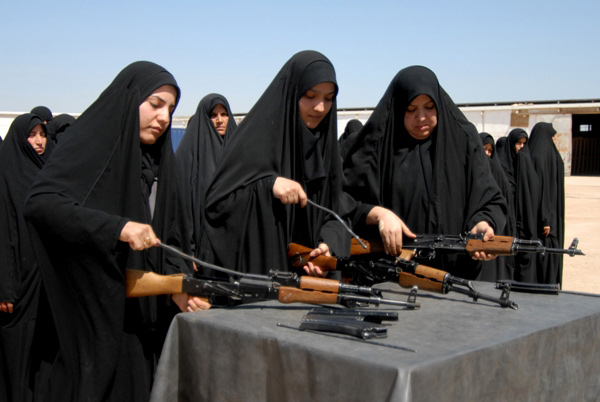According to unofficial statistics, for every 5 personal weapons present in the world, 1 of them is the AK-47.
November 13, 1947 – AK-47 assault rifle completed
The AK-47 assault rifle was the most widely used personal weapon in the 20th century Until the beginning of the 21st century, despite 70 years of life, the AK-47 and its versions were the weapon. the most popular, selected as a standard weapon by more than 50 armies, it also serves many other armed forces, guerrillas in more than 100 countries around the world. Its low cost, reliability and extremely high efficiency in extreme combat conditions make it the most popular personal weapon in the world. Its most effective range is around 400m, which is used for short and medium range combat.
With its influence, the AK-47 has been called a military icon, a weapon that changes the face of war. Currently, the AK-47 is the standard personal weapon for the military of over 60 countries around the world. Many other countries also use the AK-47 for police and border forces. The AK-47 is also the choice of rebels and criminals around the world due to its high durability and low cost. It all started on November 13, 947, when the Soviet Union completed the design of this legendary weapon before it entered public service in 1949.
The AK-47 assault rifle was considered a necessary invention for the battlefield at this time when the development of infantry tactics changed a lot since muskets appeared in this way. about 1 to 2 centuries. From horizontal staging, firing and reloading tactics to trench tactics that took advantage of machine guns, barbed wire, and bunkers during WWI; in the stage of the second world war was an infantry tactic in groups of 5 to 6 with the support of armored vehicles, air force and artillery.
More and more, the advantage of the rate of fire is more and more important, so in addition to the traditional single shot rifles (M1903 Springfield, Lee Enfield, Mauser Kar98k and Mosint Nagant) continuous fire rifles with small loaders such as M1 Garand, M1 Carbine, Gewehr 43 and SKS-40 have also gradually asserted their position. But their rate of fire is still nothing compared to the submachine like M1A1 Thompson, MP-40, Sten or PPSH-41; Around this time, weaponry experts came up with the idea of combining the rate of fire of submachine guns and the power of rifles in a new weapon called the assault rifle with its pioneer, the StG-44.
 German StG-44 rifle.
German StG-44 rifle.
The AK-47’s origin dates back to the end of WWII, the Germans developed the StG-44 (Sturmgewehr 44) gun, based on research showing that the majority of shootings took place in proximity, less than 300m. The rifle power (bolt) was too strong at this time (effective range was 800m) but when the shot density was too low for most of the close range combat.
The conclusion of the German army is that there is a need to invent a pistol that combines a rifle and a submachine gun with basic characteristics like a large ammo box, thick and precise firepower at medium range. The efficiency reaches 300m. To reduce production costs, the Mauser MP-40 submachine gun has been improved, not using 9x19mm ammunition, but instead using 7.92x33mm ammunition, which has a higher dose of thruster.
While there are many drawbacks such as an effective range of around 300m (barely better than submachine gun types), the pistol has no single shot mode, no manual padding, but the StG -44 is always considered. “Guys” usher in a new era of soldier fighting skills.
The father of the AK-47, Mikhail Kalashnikov, took advantage of the superior properties of the StG-44 and combined with the real rifle ammunition which had great destructive power at the time was 7.62×41 mm. , 62x39mm from now) to create a firearm entered the competition to design a new personal weapon with the requirement to be reliable in the muddy, wet and cold environments of the Soviet Union.
It was a rifle that worked on the principle of horizontal gas extraction, unlocking the barrel to reload with a curved cartridge containing 30 rounds. Its models of firearms (AK-1 and AK-2 markers) proved to be reliable and outperformed their competitors.
 Ak-47 and “father” Mikhail Kalashnikov.
Ak-47 and “father” Mikhail Kalashnikov.
At the end of 1946, when the weapons were being tested, the soldiers reluctantly accepted the AK at first. They were used to treating their opponents with a common rifle at this time like the Mosint Nagant.
However, in the end, Kalashnikov’s assistant Aleksandr Zaytsev convinced them, as a result, the new gun left a lot of holes in the target and passed the test shot on the testing ground. Also from there, the Kalashinkov rifle of 1947 proved its reliability, simplicity, and began to be equipped with the Soviet Army in 1949 under the name of Kalashnikov automatic rifle, or AK. 7.62 mm caliber. Although Kalashnikov denied that the AK-47 was based on the German StG 44 pistol, the AK-47 is believed to have been influenced by the design of the StG-44.
The main advantage of the AK-47 is its simple design, compact size and easy mass production. The gun has a low production cost, is easy to clean and maintain; at the same time, its high durability and reliability were legendary. In fact, the accuracy of the AK-47 is not as reliable as previous models, although with a 30 round magazine the soldier has a chance with the other 29 if the first one does not hit.
This was the influence of Soviet infantry doctrine of this era, when rifles were seen as part of close-range infantry concentration rather than long-range precision. The AK-47’s lifespan varies from 20 to 40 years depending on the environment used for maintenance.
During the Cold War, the countries of the Soviet Union, the People’s Republic of China, and the United States supplied and supplied a wide range of weapons and military technology to their allies and organizations. At that time, weapons used in the US military such as the M14s and M16s were very expensive, so the US mainly gave its surplus old generation weapons to its allies. Meanwhile, AK’s low cost of production allowed the Soviet Union to build this weapon in large numbers and supply it with allies in place of traditional weapons. As a result, during the Cold War, AK was exported in large quantities (even for free) by the Soviet Union and the PRC to countries and their allied organizations, such as the Liberation Army. South Vietnam and National Front for the Liberation of the Sandinistas in Nicaragua. AK weapons are present in the military of over 60 countries and hundreds of other paramilitary organizations.
Even at the end of the Cold War, the AK-47 was still the most popular weapon in the world. Due to its very high reliability performance in non-standard combat conditions. Even when it is removed from the mud, just pull it out, use water to wash the parts and put it back together. The materials used to make firearms are relatively common, mainly steel and wood. In a context of low technological development, many developing countries and some less developed countries have also manufactured this weapon at a relatively low price.
 The Ak-47 is so easy to use that women can master the assembly and maintenance of firearms.
The Ak-47 is so easy to use that women can master the assembly and maintenance of firearms.
According to economist Phillip Killicoat, University of Oxford, UK, the average price of an AK-47 sold in 2005 was $ 534. Meanwhile, in Africa alone, AK-47s are sold for around $ 200 cheaper (only an eighth the price of an M-16), and pirated AKs can be even cheaper. again.
Because the structure is not too complicated, easy to disassemble, and only needs a few simple mechanical tools, the shooter can easily maintain and repair the small ones. Auxiliary parts: hand guard, handle, trigger handle are all made of wood, so it is easy to make yourself by model. As of mid-2012, demand for AK-47 in the global market is still very strong with more than 100 million produced worldwide.
Even the American public rushed to buy the AK-47 for an amount equal to the amount held by the Russian military and police and was called “quality and versatility above all else.” other on the market. ”According to unofficial statistics, for every 5 personal weapons in the world, 1 of them is the AK-47.
The popularity of the AK-47 is not only reflected in its production and sales. The AK-47’s reputation in wars, military conflicts, and violent activities imprinted its image on the human subconscious and has become a symbol of combativeness.
Even the symbols of some countries and organizations also use the shape of the AK-47 as an iconic element in addition to other iconic elements. The AK image appeared on Mozambique’s flag and coat of arms, a recognition that the leaders of those countries gained power in part through the effective use of AK-47s.
It also appears on the coats of arms of Zimbabwe and East Timor, the coat of arms of Burkina Faso in the years 1984-1997, the flag of the Hezbollah organization and the emblem of the Islamic Revolutionary Guards of Iran.


